Homemade jam with fresh figs, citrus zest, and real vanilla bean is a special treat, and easier to make than you may think! This simple fig jam recipe takes just 4 ingredients and there’s no canning required—just cook and refrigerate.

Years ago, a neighbor gave me a small clipping from her fig tree. I was skeptical—I don’t have a green thumb—but I planted it anyway. More than a decade later, the clipping is now a tree that hovers over the roof of my garage. Every year, in spite of my neglect, it gives me a bounty of fruit that I never quite feel I deserve but for which I am truly grateful, especially when I make this fig jam recipe.
Truth be told, the figs aren’t fantastic—they’re small and rather dry. But this recipe transforms my Plain Jane figs into a delicious sweet preserve, perfect for spreading on toast, adding a dollop to my morning yogurt, baking into crostatas, topping cakes, Italian Pinch Cookies, on top of Baked Brie, and beyond! I simply cook the fresh figs down with sugar, a little lemon and orange peel, and vanilla bean, which gives them a depth of flavor and balance to the sweetness
If you’ve never made homemade jam before you will be surprised at how easy it is. And there’s no canning required—no sterilizing jars, no processing in a water bath. You don’t even have to peel the figs.
Before you know it, you’ll have a pretty batch of delicious seed-speckled fresh fig jam. Keep some for yourself and share a jar or two with family and friends. The jam will keep in the refrigerator for up to 1 month, and in the freezer for up to 1 year.
Table of Contents

Ingredients for this Fig Jam Recipe
The ingredient list for this small-batch fig jam recipe is short and sweet. Here’s a detailed look at what you need.
- Figs: Look for ripe–but not overripe–figs with no bruises, soft spots, or blemishes.
- Sugar: You can use either plain granulated sugar or golden sugar, a slightly less-processed sugar that retains some molasses and adds a little more depth of flavor.
- Citrus juice and zest: You can use either lemon or orange—or a little of each, which is what I do. Use both the juice and finely chopped zest to add both flavor and to help “set” or thicken the jam with its natural pectin.
- Vanilla bean: The seeds of a vanilla bean add warmth and depth to fig jam, nicely rounding out its flavor.
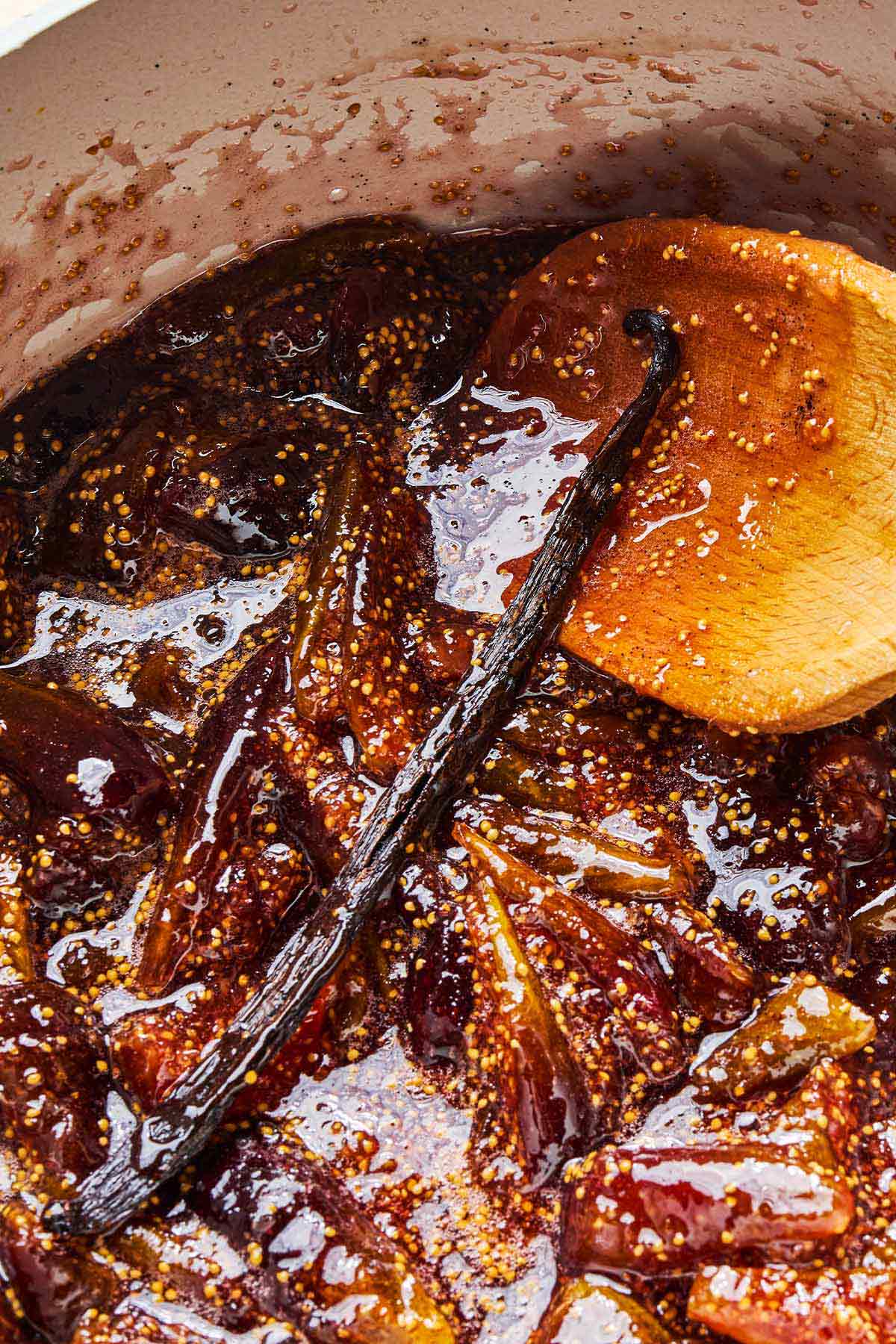
Which Figs are Best for Jam?
There are many varieties of figs with different flavor and texture characteristics. In color they range from light green to blue-black on the outside, and from pale pink to ruby red inside. And all of them can be turned into jam. Look for locally grown figs at farmers’ markets and grocery stores. Here are some common varieties available in the U.S., though the selection may differ depending on where you live.
- Adriatic: These pale green figs have bright red flesh and are super sweet. In Italy they are known as fichi grassi, meaning “fat” figs, so called because they plump up so much when ripe that they literally burst their seams with juice.
- Brown Turkey: Smaller than some other fig varieties, Brown Turkey figs have skin that falls somewhere between dusky purple and chocolate brown; inside their flesh is reddish pink. They have a mild, slightly earthy flavor and are on the less-juicy side. But they make excellent preserves, turning sweet, with notes of caramel, when cooked down.
- Calimyrna: Green-gold in color with bright pink flesh, Calimyrna figs are relatively large. They have a sweet, slightly nutty flavor, and turn an appealing amber color when cooked down into jam.
- Mission: Purple-black Mission figs are sweet and syrupy when ripe. They have a dusky bloom on their skin; inside their flesh is pink-to-red. This is the variety you’re most likely to find in supermarkets. It’s also what our favorite Sicilian fig jam is made out of.
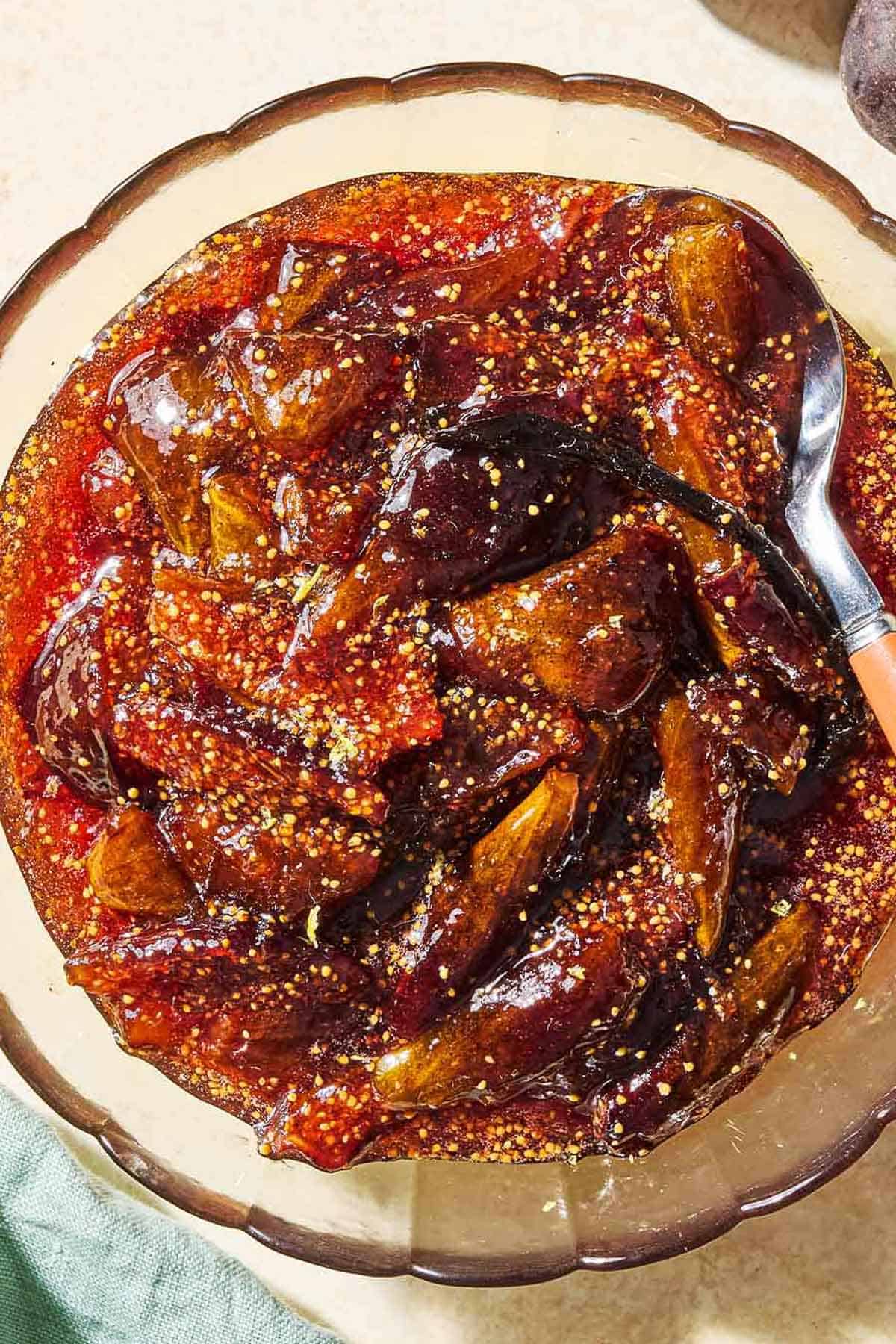
Equipment to Make Homemade Fig Jam
Unlike jam that is canned, you don’t need any special equipment to make this quick fig jam. Here’s what you’ll need.
- Dutch oven or other non-reactive heavy-bottomed sauté pan: Enameled cast iron and stainless steel are both nonreactive materials that will not react with the acidity of preserves, which means they will not affect your jam’s flavor or color. A medium-sized enameled cast iron Dutch oven (like Le Creuset or Staub), or a stainless-steel sauté pan with straight sides and a heavy bottom (like this one) are both ideal for making jam. These pots allow steam and moisture to escape so the jam can thicken, and the heavy bottom makes for even cooking and prevents burning.
- Silicone or wooden spatula: I use a sturdy silicone spatula with a wooden handle or a wooden spoon to stir the jam as it simmers and bubbles on the stovetop. Both work well, but a silicone spatula is better at cleaning jam off the sides of the pan.
- Candy thermometer: A stainless-steel candy thermometer does an accurate job of measuring the temperature of jam as it heats. To properly set your jam, you’ll need to heat the mixture to 220°F.
- Mason jars: You can store this jam in pretty much any container, but a classic glass jar makes an attractive vessel. You’ll need 3 half-pint (8-ounce) jars for this recipe. If you’re storing the jam in the freezer, use a plastic container with a tight-fitting lid.

How to Make this Fig Jam Recipe
Believe it or not, you can have freshly made homemade jam in just about an hour. It’s the perfect easy project for a Saturday morning. Just follow these instructions and look for the cues for doneness. Here’s how to do it.
- Start by cleaning and prepping the figs and citrus. Cut the tips off 2 pounds of fresh figs and gently wash them by placing them in a colander and running warm water over them. Wash 2 lemons or oranges and use a vegetable peeler to peel off the zest, taking care to leave behind any white pith. Finely chop the zest and squeeze the juice from the fruit. You’ll need 1 to 2 tablespoons of zest and about 6 tablespoons juice. Split the pod in half lengthwise, then scrape the vanilla bean seeds from the pod.
- Macerate. Cut the figs into quarters and place them in a medium Dutch oven or deep-sided sauté pan with a heavy bottom. Pour 2 cups sugar over the figs, followed by the orange or lemon juice, finely chopped zest, and vanilla pod and seeds. Gently stir everything together. Let the mixture macerate for 30 minutes to dissolve the sugar.
- Cook the jam. Set the pot over medium-high heat and bring the fruit to a boil. Then lower the heat and simmer until it has turned several shades darker and transformed into a thick and glossy mixture. There should still be pieces of figs visible. Stir often to prevent burning and watch out for splatters!
- Finish the cooking. Continue to cook the mixture at a lively simmer—always watching out for spatters—until it reaches 220°F on a candy thermometer. You should be able to drag a path along the bottom of the pot through the jam.
- Cool and store. Remove the pot from the heat, discard the vanilla bean, and let the jam cool; then transfer it to clean jars or a clean container. Cover tightly and refrigerate for 3 weeks or freeze for up to 1 year. If freezing allow 1 1/2 inches of headspace to allow for expansion.
No Candy Thermometer? Use The Freezer Test.
Though it’s helpful, you don’t absolutely need a candy thermometer for this fig jam recipe. Here’s a trick to test the jam for doneness if you don’t have one:
- Chill a couple of small bowls, plates, or teaspoons in the freezer.
- Remove the thickened preserves from the heat to prevent further cooking. Spoon a little jam onto a chilled plate or spoon and set it in the freezer for 2 to 4 minutes.
- The spread should be thick enough that it wrinkles slightly when you nudge it with your finger, and moves slowly when you tilt it. If it’s runny, return the pot to the heat and cook for another 2 to 3 minutes before testing again.
- Remember, though, that the jam will thicken as it cools. Be careful not to overcook, as overcooked jam can turn rubbery in texture.
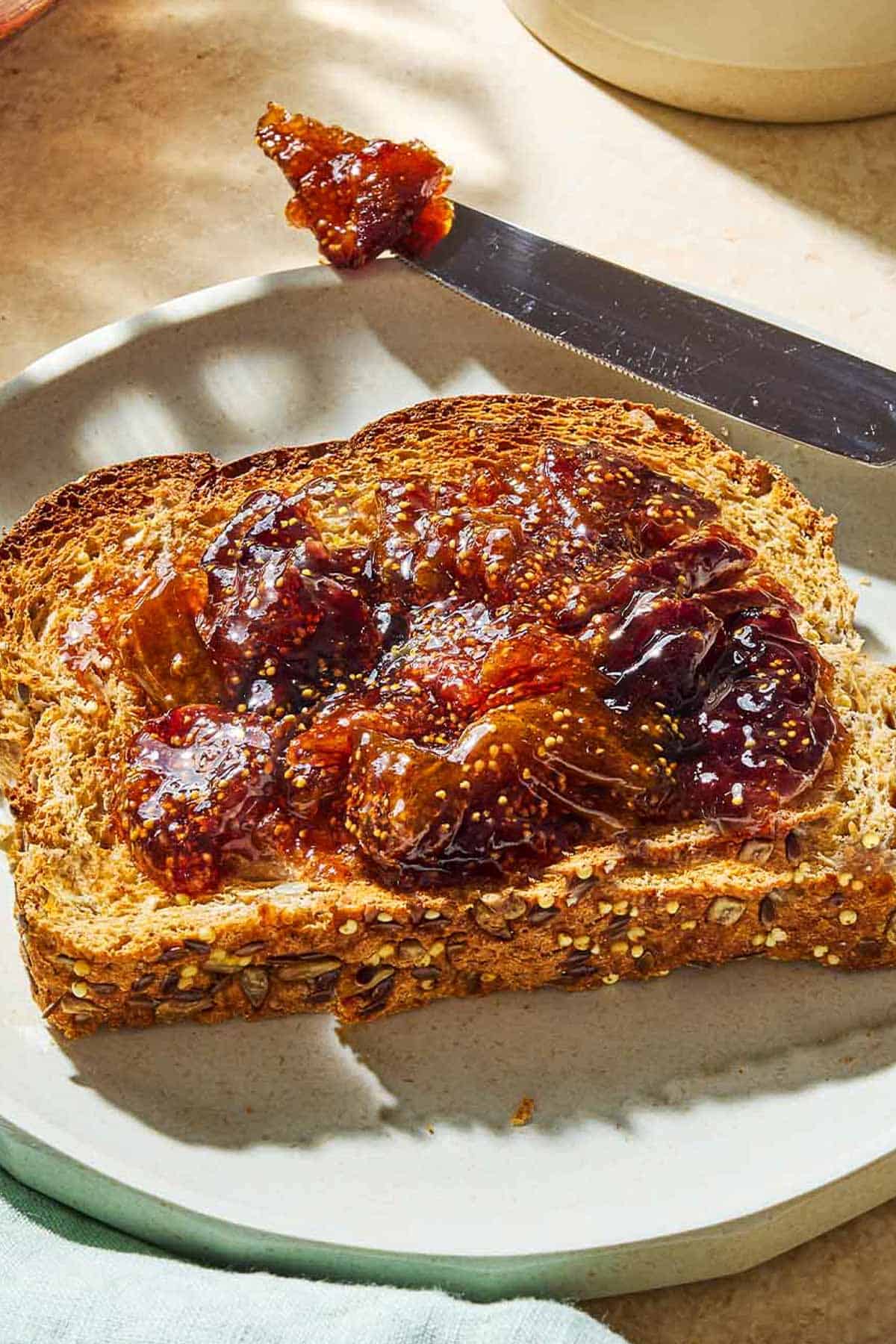
Ways to Use Fig Jam
Spreading homemade fig jam on warm toast is a special treat, but don’t stop there! Some more ideas:
- Add it to yogurt. Stir a tablespoon into a bowl of plain yogurt to sweeten it, or layer it with yogurt, fresh fruit, and granola for a yogurt and fig jam parfait.
- Serve with cheese. Fig jam goes great with many kinds of cheese, including soft, creamy cheeses, nutty semi-hard cheese, and even blue cheese. Place a small bowl of jam, along with a small spoon, on your Cheese Board along with your favorite cheeses.
- Bake it with brie. Speaking of cheese, try your homemade jam in our Baked Brie with Fig Jam.
- Put it in a sandwich. Fig jam is a surprisingly delicious sandwich condiment. Spread a little on a slice of good bread, along with a dollop of mustard. Top with ham, cheese (I like brie or cheddar, and arugula or lettuce and the other half of the bread.
- Make jam cookies. Substitute fig jam for the strawberry jam in our Pizzicati (Italian pinch cookies).
- Make a jam tart. Use your homemade jam in our sweet and savory Easy Fig Pastry with goat cheese and walnuts.
- Make a jam cake: Try adding fig jam to a simple cake, like this Fig Cake with Almond and Honey. Dollop the jam into the batter in the cake pan before baking and use a knife to swirl it around. Bake as directed.
- Can’t get enough figs? Spread your homemade fig jam on homemade Fig Bread.
More Fresh Fig Recipes
Desserts
Fig Cake with Almond and Honey
Desserts
Easy Fig Pastry Recipe
Appetizer and Mezze
Fig Pistachio Goat Cheese Crostini
Appetizer and Mezze
Prosciutto Wrapped Figs with Goat Cheese, Honey, and Thyme
Browse all Mediterranean Recipes
Visit Our Shop
Easy Fig Jam with Vanilla and Citrus

Ingredients
- 1 whole vanilla bean
- 2 pounds fresh figs (such as Brown Turkey or mission), trimmed and quartered
- 2 cups granulated sugar
- Finely chopped zest and juice of 2 lemons (about 1-2 tablespoons zest and 6 tablespoons juice)
Instructions
- Macerate the figs. Use a small knife to split the vanilla bean in half lengthwise and scrape out its seeds. Add both the seeds and pod to a heavy-bottomed non reactive saucepan or Dutch oven, along with the figs, sugar, citrus zest, and citrus juice. Gently toss everything together with a silicone spatula or wooden spoon. Let the mixture macerate for 30 minutes to dissolve the sugar.
- Reduce into a jam. Set the pot over medium-high heat and bring to a boil. Reduce the heat to medium and cook at a lively simmer for 15 to 20 minutes, until the jam is thick and glossy and has turned a couple of shades darker. Stir often to prevent burning and watch out for spatters—boiling jam is hot! Continue to simmer the mixture until it reaches 220°F on a candy thermometer and you can drag a path through the bottom of the pot with your spatula. (If you don’t have a candy thermometer, see note.)
- Cool. Remove the pot from the heat and discard the vanilla bean. Let the jam cool until it is just warm. Transfer it to clean jars or a clean container. (If you’re using a plastic container, make sure the jam is completely cool before transferring it.)
- Use or store. Store the jam in the refrigerator for 3 weeks, or in the freezer for up to one year. If freezing, leave 1 1/2 inches of headspace to allow for expansion. To use frozen jam, remove the container from the freezer and place it in the refrigerator to thaw. Use within 3 weeks.
Notes
- Visit our shop to browse quality Mediterranean ingredients including olive oils, honey, jams, and spices.
- To thaw frozen jam, place the container in the refrigerator to soften and use within 3 weeks. If you notice any mold growing on the surface of the jam, discard it as it has begun to spoil.
- No Candy Thermometer? Use The Freezer Test:
-
- Chill a couple of small bowls, plates, or teaspoons in the freezer.
- Remove the thickened preserves from the heat to prevent further cooking. Spoon a little jam onto a chilled plate or spoon and set it in the freezer for 2 to 4 minutes.
- The spread should be thick enough that it wrinkles slightly when you nudge it with your finger, and moves slowly when you tilt it. If it’s runny, return the pot to the heat and cook for another 2 to 3 minutes before testing again.
- Remember, though, that the jam will thicken as it cools. Be careful not to overcook, as overcooked jam can turn rubbery in texture.
Nutrition

Fig Jam, Year-Round
When the market isn’t overflowing with fresh figs, try this Scyavuru Black Fig Jam from the gardens of Ribera on the southern coast of Sicily.




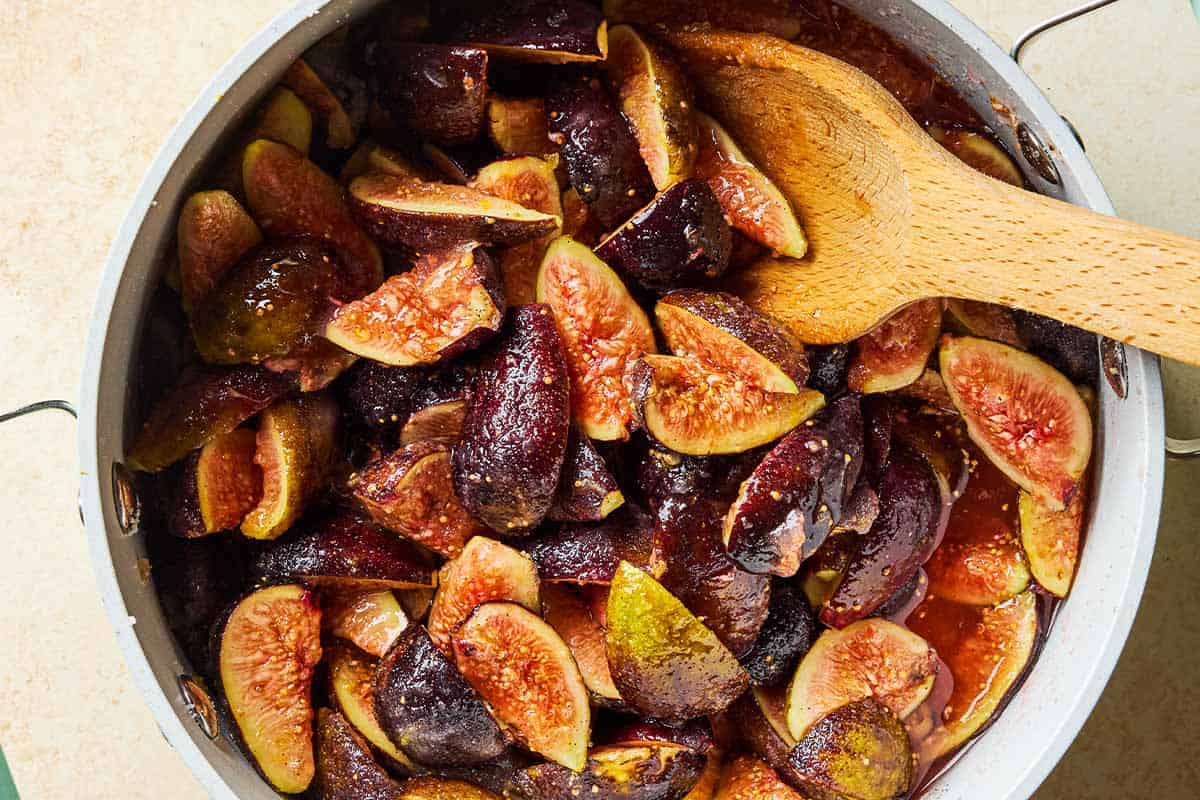
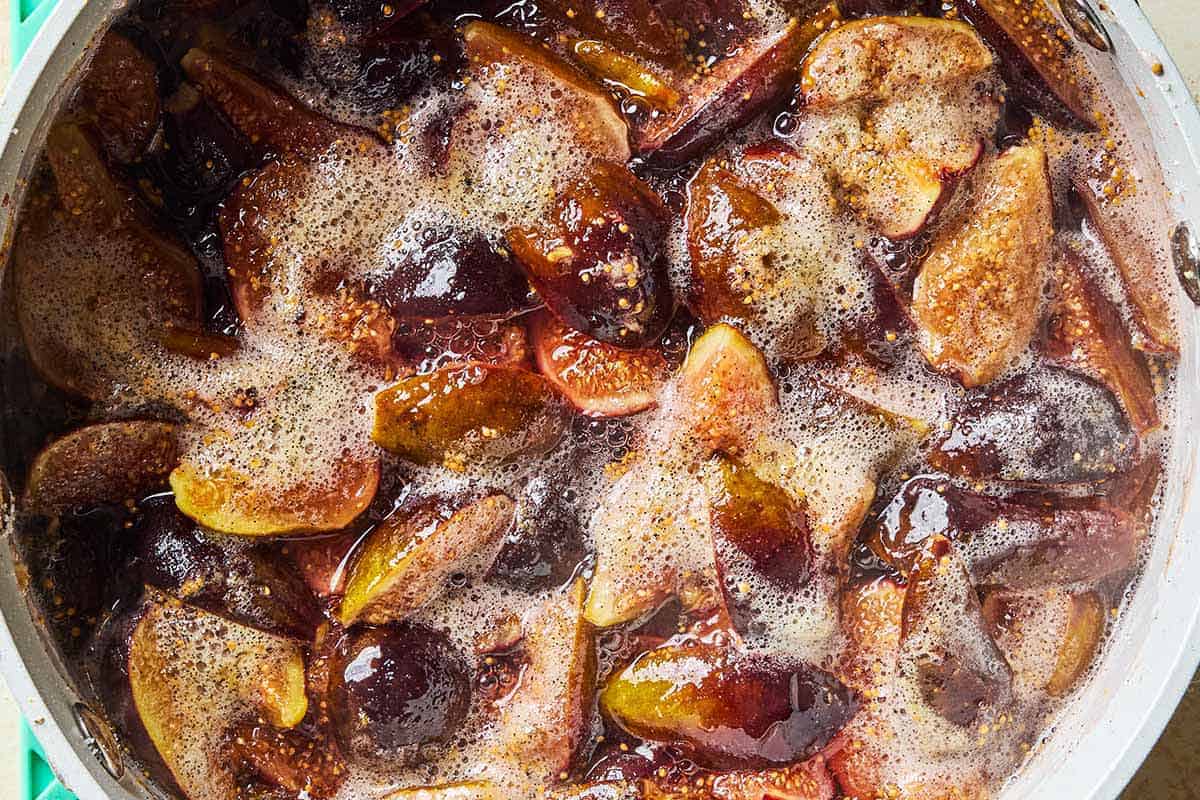






I can’t get fresh figs here. Can I use dried figs for making this?